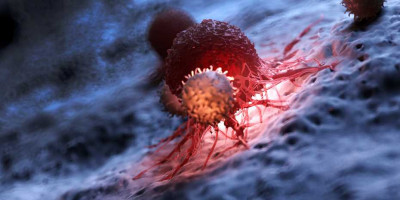
Immunotherapy using checkpoint inhibitors can work well to treat cancer, but only a minority of patients respond to therapy. Researchers at the University of Alabama at Birmingham have now shown — in preclinical experiments — how to identify non-responding tumours and improve their response to immunotherapy, as shown by limited tumour growth and extended survival.
Because their treatment paradigm uses an investigational imaging agent and a new drug therapy that is permitted for human use, UAB researchers Ben Larimer, Ph.D., and Anna Sorace, Ph.D., say physicians could immediately start investigational research in patients to test the effectiveness of this personalised approach.
The imaging agent they used is 18F- FMISO, which binds in parts of the body that are low in oxygen. The radioactive 18F- FMISO can then be detected by positron emission tomography (PET) scans. This allows rapid and noninvasive hypoxic (lack of oxygen) imaging of the whole body. 18F- FMISO has previously been investigated by others to monitor response to some cancer treatments, but it had not been investigated in association with immunotherapy.
Hypoxia, or low oxygen, is a common characteristic of many tumour microenvironments, where it can suppress anti-tumour immunity. The UAB researchers wondered whether hypoxia could distinguish tumours that would respond, or fail to respond, to immunotherapy. They used mouse models of colorectal cancer and triple-negative breast cancer to test this question.
The researchers measured hypoxia at the tumour sites prior to starting immunotherapy, and then again at five days into immunotherapy. Some tumours of each type showed relatively stable oxygenation levels from day 0 to day 5, though other tumours showed a significant increase in hypoxia by day 5. This increase in hypoxia was not due to tumour size.
By following subsequent changes in tumour volume and overall mortality, the UAB team was able to use quantified imaging from the PET scans to stratify tumours into responders, which showed limited tumour growth and better survival, or non-responders that showed increased tumour growth and poorer survival.
Since increased tumour hypoxia preceded the anatomical growth of tumours, this appears to be a potential biomarker for predicting checkpoint blockade resistance.
Larimer and Sorace, both assistant professors in the UAB Department of Radiology Division of Advanced Medical Imaging Research, found that responders and non-responders differed greatly in terms of proinflammation versus immune suppression. Investigation of excised tumours showed that the majority of normoxic tumours had an overall inflamed phenotype, while the majority of hypoxic tumours were non-inflamed.
Analysis of mRNA expression for a number of immune signalling pathways showed normoxic tumours had significantly increased expression of adaptive immune signalling proteins, chemokines, cytokines and interleukins.
Functionally, normoxic tumours contained a significantly lower relative number of exhausted CD8 killer T cells that are no longer able to control tumour progression, as compared to hypoxic tumours.
Dendritic cells — an important part of the adaptive immune system — were relatively enriched in normoxic tumours compared to hypoxic tumours, and the normoxic tumours contained a greater number of tumour-infiltrating lymphocytes and macrophages. All of these indicated a direct correlation between the presence of immune cells and oxygenation levels.
The tumours also differed in the spatial organisation of the immune cells. Normoxic tumours showed a stratification and organised structure of antigen-presenting cells like macrophages and dendritic cells, while hypoxic tumours had less structural organisation of the immune cells.
The normoxic responding tumours also had an increase in both classically activated M1 macrophages and alternatively activated M2 macrophages, which is consistent with a TH1 proinflammatory immune response by helper T cells.
Consistent with that, the normoxic tumours showed increased TH1 signalling via the damage-associated molecular pattern signalling pathways, or DAMP, including downstream markers of successful T cell activation.
But what about improving the immunotherapy response of the hypoxic, immunosuppressive tumours? That question involved the use of an investigational new drug, evofosfamide, which indeed turned out to be beneficial in the mouse models of colorectal cancer and triple-negative breast cancer.
Evofosfamide is a prodrug that becomes active only in hypoxic environments, such as those common in human solid tumours. The active drug causes cells to undergo programmed cell death, or apoptosis, which would release DAMP proteins.
After the UAB researchers stratified tumours via 18F- FMISO PET imaging, the prodrug evofosfamide was given to those mice that had hypoxic tumours, along with continued immunotherapy. In controls, immunotherapy treatment alone for normoxic tumours reduced tumour volume and extended overall survival. However, immunotherapy treatment alone for hypoxic tumours did not control tumour growth and failed to improve survival. Evofosfamide treatment given without therapy had negligible effect.
However, the addition of evofosfamide to hypoxic tumours undergoing immunotherapy significantly reduced hypoxia, and enhanced the overall therapeutic efficacy. This was measured by a significant reduction in tumour volume and extended overall survival of the mice.
“If the mechanism of hypoxia is conserved across species, then 18F- FMISO can serve to guide the timing of evofosfamide in personalised and image-guided adaptive immunotherapy trials,” Larimer and Sorace said.
“Both 18F- FMISO and evofosfamide have been approved as investigational new drugs by the United States Food and Drug Administration, and therefore, rapid clinical exploration is possible to test the translation of our described paradigm. If successful, this strategy may act to rescue otherwise non-responsive tumours and enhance the number of patients who benefit from immunotherapy.”
We are an independent charity and are not backed by a large company or society. We raise every penny ourselves to improve the standards of cancer care through education. You can help us continue our work to address inequalities in cancer care by making a donation.
Any donation, however small, contributes directly towards the costs of creating and sharing free oncology education.
Together we can get better outcomes for patients by tackling global inequalities in access to the results of cancer research.
Thank you for your support.